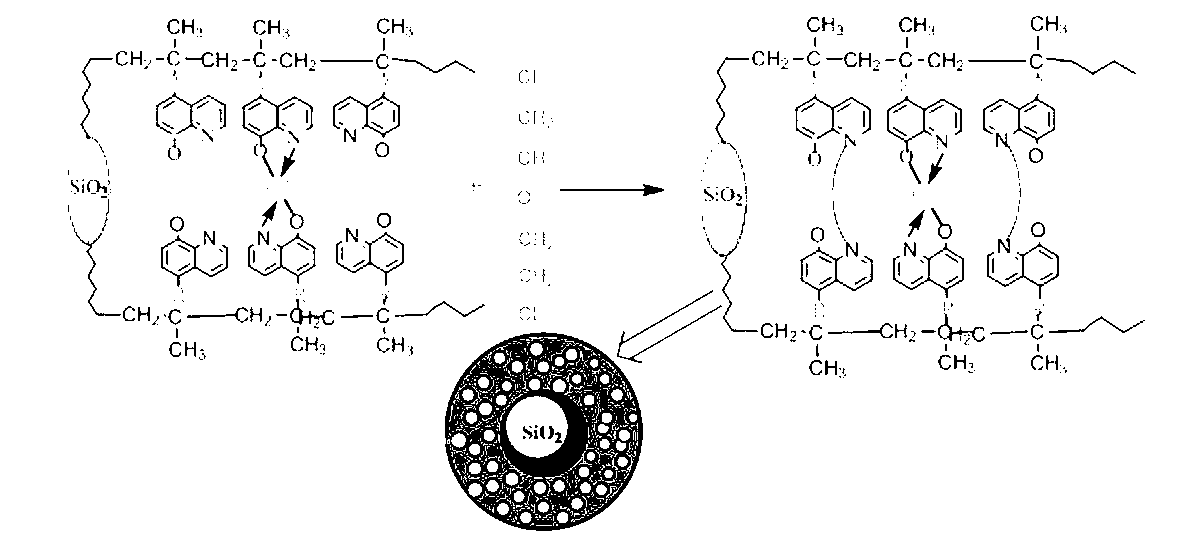Preparation method of cadmium ion surface imprint adsorbing material
A technology of surface imprinting and adsorption materials, applied in chemical instruments and methods, adsorption water/sewage treatment, other chemical processes, etc. It is difficult to identify problems such as site binding, and achieve the effects of high elution efficiency, high mechanical strength, and easy control.
- Summary
- Abstract
- Description
- Claims
- Application Information
AI Technical Summary
Problems solved by technology
Method used
Image
Examples
example 1
[0016] Example 1: Put 0.1 g of functional grafted particles HQ-PHEMA / SiO2 (the degree of grafting of PHEMA is 40 g / 100 g, the bonding density of HQ is 1.85 mmol / g) in 500 mL of 0.01 mol / L Cd 2+ In the ionic water solution, adjust the pH value of the solution system with dilute sodium hydroxide solution to make pH = 5.5, place the mixed solution in a constant temperature oscillator, and shake at a constant temperature for 4 h to make the functional grafted particles HQ-PHEMA / SiO 2 to Cd 2+ The adsorption of ions reaches saturation, and the particles are filtered out and dried in vacuum. 0.5 g of saturated adsorbed Cd 2+ Ionically functional grafted microparticles placed in Cd-containing 2+ ions (0.01mol / L) in a mixed solvent of water and ethanol (the volume ratio of water and ethanol is 7:3), adjust the pH value of the system with dilute NaOH solution to make pH = 5.5, add 5 mL of dichloro Aqueous diethyl ether solution (1%) was stirred at 45°C for 24 h for the cross-linkin...
example 2
[0017] Example 2: 0.1 g of functional grafted particles HQ-PHEMA / SiO 2 ( The degree of grafting of PHEMA is 30 g / 100 g, and the bonding density of HQ is 1.75 mmol / g) placed in 500 mL of Cd with a concentration of 0.01 mol / L 2+ In the ionic water solution, adjust the pH value of the solution system with dilute sodium hydroxide solution to make pH = 5.5, place the mixed solution in a constant temperature oscillator, and shake at a constant temperature for 4 h to make the functional grafted particles HQ-PHEMA / SiO 2 to Cd 2+ The adsorption of ions reaches saturation, and the particles are filtered out and dried in vacuum. 0.5 g of saturated adsorbed Cd 2+ Ionically functional grafted microparticles placed in Cd-containing 2+ ions (concentration of 0.01mol / L) in a mixed solvent of water and ethanol (volume ratio of water and ethanol is 7:3), use dilute NaOH solution to adjust the pH value of the system to pH = 5, add 4 mL of dichloro Aqueous diethyl ether solution (1%) was sti...
example 3
[0018] Example 3: 0.1 g of functional grafted particles HQ-PHEMA / SiO 2 ( The degree of grafting of PHEMA is 35 g / 100 g, and the bonding density of HQ is 1.8 mmol / g) placed in 500 mL of Cd with a concentration of 0.01 mol / L 2+ In the ionic water solution, adjust the pH value of the solution system with dilute sodium hydroxide solution to make pH = 5.5, place the mixed solution in a constant temperature oscillator, and shake at a constant temperature for 4 h to make the functional grafted particles HQ-PHEMA / SiO 2 to Cd 2+ The adsorption of ions reaches saturation, and the particles are filtered out and dried in vacuum. 0.5 g of saturated adsorbed Cd 2+ Ionic functional particles placed in the Cd-containing 2+ ions (concentration of 0.01mol / L) in a mixed solvent of water and ethanol (the volume of water and ethanol is 7:3), adjust the pH value of the system with dilute NaOH solution to make pH = 4.5, add 6 mL of dichloro Aqueous diethyl ether solution (1%) was stirred at 50°...
PUM
| Property | Measurement | Unit |
|---|---|---|
| Degree of grafting | aaaaa | aaaaa |
| Degree of grafting | aaaaa | aaaaa |
| Degree of grafting | aaaaa | aaaaa |
Abstract
Description
Claims
Application Information
 Login to View More
Login to View More - R&D
- Intellectual Property
- Life Sciences
- Materials
- Tech Scout
- Unparalleled Data Quality
- Higher Quality Content
- 60% Fewer Hallucinations
Browse by: Latest US Patents, China's latest patents, Technical Efficacy Thesaurus, Application Domain, Technology Topic, Popular Technical Reports.
© 2025 PatSnap. All rights reserved.Legal|Privacy policy|Modern Slavery Act Transparency Statement|Sitemap|About US| Contact US: help@patsnap.com


